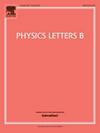Null geodesics and shadows of Dekel-Zhao-type dark matter black holes with a quintessential field: Constraints from EHT observations of M87* and Sgr A*
IF 4.5
2区 物理与天体物理
Q1 ASTRONOMY & ASTROPHYSICS
引用次数: 0
Abstract
One compelling way to probe dark matter is by looking for its gravitational effects on black holes. Inspired by the study of Cardoso et al. (Phys. Rev. D 105, 6, L061501 (2022)) on black holes in galaxies, this work investigates static, spherically symmetric black holes surrounded by Dekel-Zhao-type dark matter halos and influenced by a quintessential field. By adopting a double power-law profile, we derive explicit expressions for the cumulative mass, tangential velocity, and the modified metric, providing a coherent description of the horizon structure and thermodynamic properties. Depending on the core density, the spacetime may feature multiple horizons or even a naked singularity. Our analysis of null geodesics reveals that both dark matter and quintessence significantly affect photon trajectories and the resulting black hole shadow. By combining theoretical modeling with EHT observations of Sgr A and M87, we place constraints on the halo density and quintessence parameter, directly connecting them to observable features. However, a stability analysis of circular photon orbits confirms that the photon sphere is inherently unstable, with its location and sensitivity strongly influenced by the surrounding matter. Finally, we analyze how the impact parameter shapes photon trajectories around a black hole, determining the bending of null geodesics, the photon sphere location, and the event horizon structure, thereby illustrating the influence of spacetime geometry on light paths. This work highlights the intricate interplay between dark matter, quintessence, and black hole observables, bridging theoretical predictions with astrophysical measurements.
具有典型场的dekel - zhao型暗物质黑洞的零测地线和阴影:来自M87*和Sgr a * EHT观测的约束
探测暗物质的一个引人注目的方法是寻找它对黑洞的引力效应。受到Cardoso等人研究的启发。Rev. D 105,6, L061501(2022))对星系中黑洞的研究,这项工作研究了由dekel - zhao型暗物质晕包围并受典型场影响的静态球对称黑洞。通过采用双幂律剖面,我们导出了累积质量、切向速度和修正度规的显式表达式,提供了对视界结构和热力学性质的连贯描述。根据核心密度的不同,时空可能具有多重视界,甚至可能存在裸奇点。我们对零测地线的分析表明,暗物质和精质物质都显著影响光子轨迹和由此产生的黑洞阴影。通过将理论建模与Sgr A*和M87*的EHT观测相结合,我们对晕密度和精华参数进行了约束,并将它们与可观测特征直接联系起来。然而,对圆形光子轨道的稳定性分析证实,光子球本质上是不稳定的,其位置和灵敏度受到周围物质的强烈影响。最后,我们分析了撞击参数b ~如何塑造黑洞周围的光子轨迹,确定零测地线的弯曲,光子球的位置和事件视界结构,从而说明时空几何对光路的影响。这项工作强调了暗物质、精粹和黑洞可观测物之间复杂的相互作用,将理论预测与天体物理测量联系起来。
本文章由计算机程序翻译,如有差异,请以英文原文为准。
求助全文
约1分钟内获得全文
求助全文
来源期刊

Physics Letters B
物理-物理:综合
CiteScore
9.10
自引率
6.80%
发文量
647
审稿时长
3 months
期刊介绍:
Physics Letters B ensures the rapid publication of important new results in particle physics, nuclear physics and cosmology. Specialized editors are responsible for contributions in experimental nuclear physics, theoretical nuclear physics, experimental high-energy physics, theoretical high-energy physics, and astrophysics.
 求助内容:
求助内容: 应助结果提醒方式:
应助结果提醒方式:


